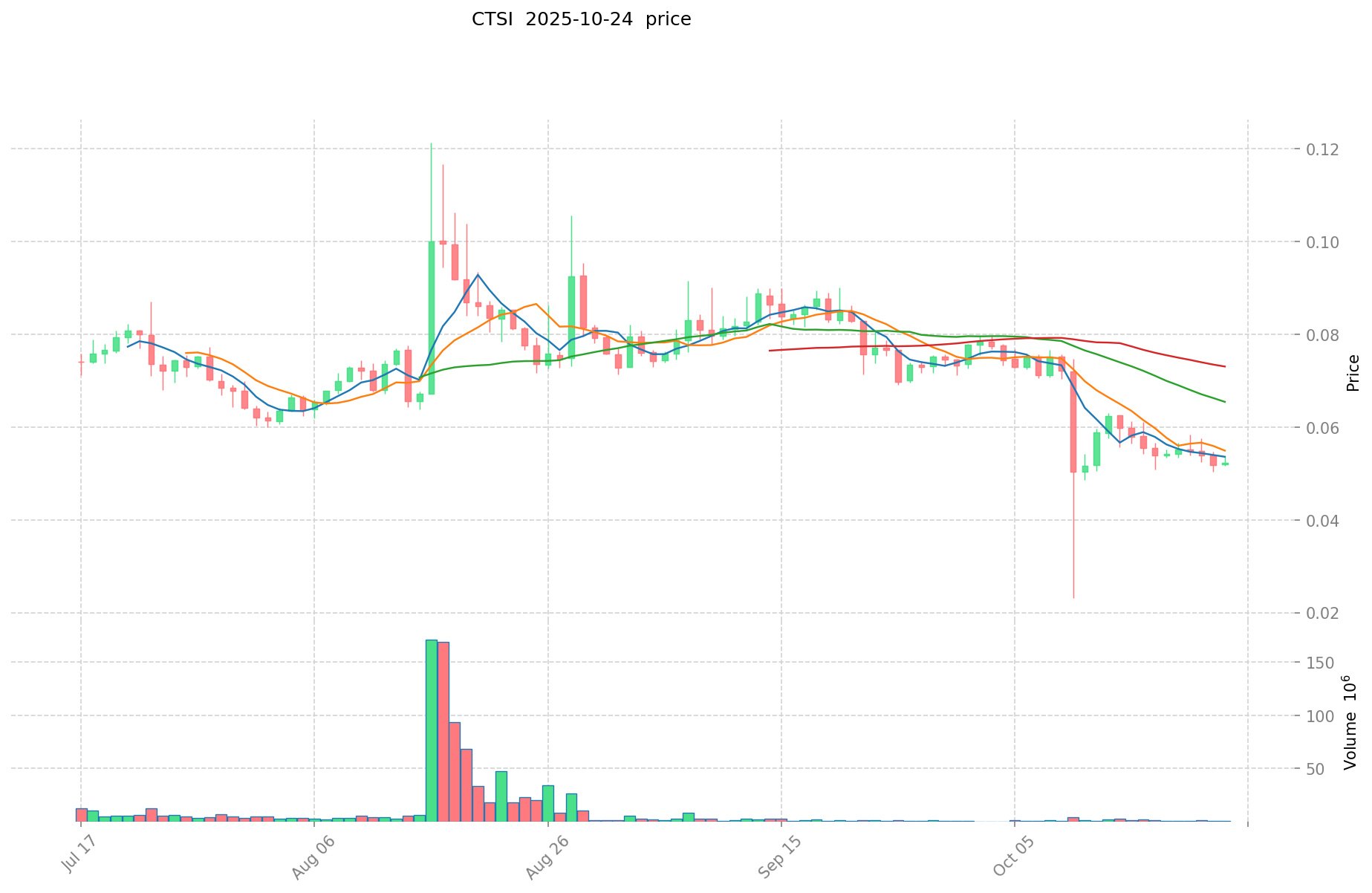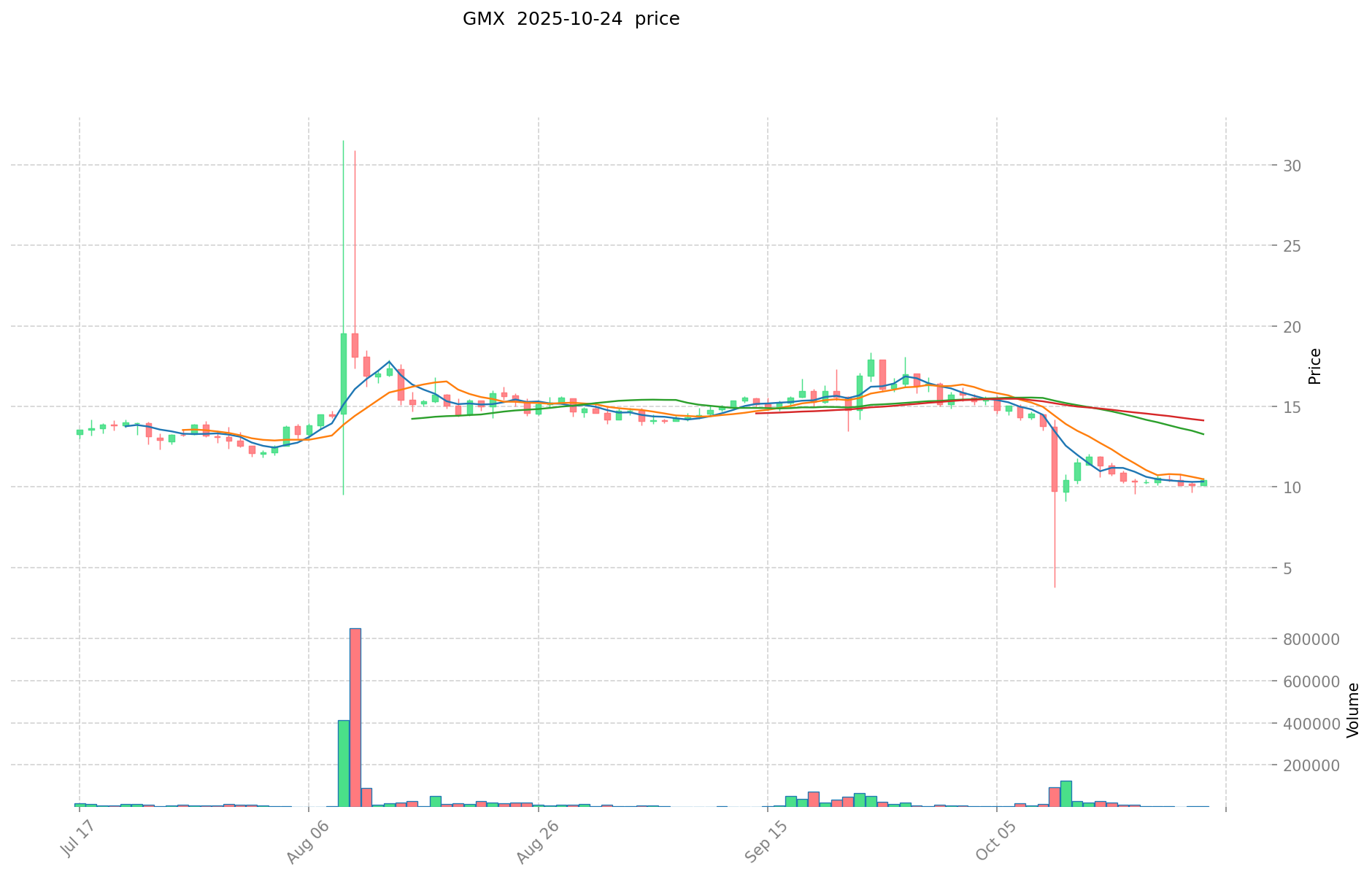CTSI vs GMX: Comparing Two Innovative Blockchain Platforms for Decentralized Applications
Introduction: CTSI vs GMX Investment Comparison
In the cryptocurrency market, the comparison between CTSI vs GMX has always been a topic that investors can't ignore. The two not only have significant differences in market cap ranking, application scenarios, and price performance, but also represent different positioning in crypto assets.
Cartesi (CTSI): Since its launch, it has gained market recognition for its off-chain computing services in a Linux environment without compromising security and decentralization.
GMX (GMX): It has been hailed as a decentralized perpetual exchange since its inception, with its token serving as both a utility and governance token.
This article will comprehensively analyze the investment value comparison between CTSI vs GMX, focusing on historical price trends, supply mechanisms, institutional adoption, technical ecosystems, and future predictions, attempting to answer the question investors care about most:
"Which is the better buy right now?"
I. Price History Comparison and Current Market Status
CTSI (Coin A) and GMX (Coin B) Historical Price Trends
- 2021: CTSI reached its all-time high of $1.74 on May 9, 2021.
- 2023: GMX hit its all-time high of $91.07 on April 18, 2023.
- Comparative Analysis: In the recent market cycle, CTSI has fallen from its high of $1.74 to a low of $0.02606722, while GMX has dropped from $91.07 to a low of $6.92.
Current Market Situation (2025-10-24)
- CTSI current price: $0.05238
- GMX current price: $10.45
- 24-hour trading volume: CTSI $38,017,082 vs GMX $24,198,849
- Market Sentiment Index (Fear & Greed Index): 30 (Fear)
Click to view real-time prices:
- Check CTSI current price Market Price
- Check GMX current price Market Price


II. Key Factors Affecting CTSI vs GMX Investment Value
Supply Mechanism Comparison (Tokenomics)
- Market Volatility: Cryptocurrency prices are primarily driven by speculation and emotional factors, causing significant fluctuations
- Investor Sentiment: Without asset or cash flow backing, sentiment changes can lead to dramatic price movements
- Economic Factors: High interest rates, persistent inflation, and geopolitical tensions affect investment activities
Institutional Adoption and Market Applications
- Market Structure: Secondary markets feature intense competition with most participants experiencing losses
- Primary Market Dynamics: New project listings often have limited initial token unlocks (around 15%)
- Risk Management: Smart investors adopt objective and rational analysis approaches
Technical Development and Ecosystem Building
- Market Uncertainty: Cryptocurrency price predictions inherently involve uncertainty due to market volatility
- External Factors: Various external elements can significantly impact cryptocurrency values
- Research Importance: Thorough research considering financial goals is essential before investment
Macroeconomic Factors and Market Cycles
- Economic Indicators: High interest rates, inflation, and geopolitical factors are key determinants
- Trading Strategies: Both long and short positions are common, with shorting generally being more challenging
- Risk Assessment: Financial markets don't experience perpetual bull markets, requiring strategic positioning
III. 2025-2030 Price Prediction: CTSI vs GMX
Short-term Prediction (2025)
- CTSI: Conservative $0.0480-$0.0522 | Optimistic $0.0522-$0.0762
- GMX: Conservative $8.99-$10.45 | Optimistic $10.45-$12.96
Mid-term Prediction (2027)
- CTSI may enter a growth phase, with prices expected in the range of $0.0355-$0.0838
- GMX may enter a consolidation phase, with prices expected in the range of $9.87-$14.01
- Key drivers: Institutional inflows, ETFs, ecosystem development
Long-term Prediction (2030)
- CTSI: Base scenario $0.0855-$0.0855 | Optimistic scenario $0.0855-$0.1017
- GMX: Base scenario $19.43-$19.43 | Optimistic scenario $19.43-$26.82
Disclaimer: The above predictions are based on historical data and market analysis. Cryptocurrency markets are highly volatile and subject to rapid changes. These projections should not be considered as financial advice. Always conduct your own research before making investment decisions.
CTSI:
| 年份 | 预测最高价 | 预测平均价格 | 预测最低价 | 涨跌幅 |
|---|---|---|---|---|
| 2025 | 0.0761828 | 0.05218 | 0.0480056 | 0 |
| 2026 | 0.069957726 | 0.0641814 | 0.051986934 | 22 |
| 2027 | 0.08383695375 | 0.067069563 | 0.03554686839 | 28 |
| 2028 | 0.09129844263375 | 0.075453258375 | 0.0437628898575 | 44 |
| 2029 | 0.087544643029593 | 0.083375850504375 | 0.058363095353062 | 59 |
| 2030 | 0.101697693652711 | 0.085460246766984 | 0.076914222090285 | 63 |
GMX:
| 年份 | 预测最高价 | 预测平均价格 | 预测最低价 | 涨跌幅 |
|---|---|---|---|---|
| 2025 | 12.958 | 10.45 | 8.987 | 0 |
| 2026 | 14.98112 | 11.704 | 7.37352 | 12 |
| 2027 | 14.009688 | 13.34256 | 9.8734944 | 27 |
| 2028 | 19.8303798 | 13.676124 | 9.98357052 | 30 |
| 2029 | 22.114292508 | 16.7532519 | 8.879223507 | 60 |
| 2030 | 26.81860564152 | 19.433772204 | 10.88291243424 | 85 |
IV. Investment Strategy Comparison: CTSI vs GMX
Long-term vs Short-term Investment Strategies
- CTSI: Suitable for investors focused on off-chain computing potential and ecosystem growth
- GMX: Suitable for investors interested in decentralized perpetual exchanges and governance tokens
Risk Management and Asset Allocation
- Conservative investors: CTSI: 30% vs GMX: 70%
- Aggressive investors: CTSI: 60% vs GMX: 40%
- Hedging tools: Stablecoin allocation, options, cross-currency portfolios
V. Potential Risk Comparison
Market Risks
- CTSI: Higher volatility, susceptible to overall market sentiment
- GMX: Exposure to perpetual exchange market fluctuations
Technical Risks
- CTSI: Scalability, network stability
- GMX: Smart contract vulnerabilities, liquidity risks
Regulatory Risks
- Global regulatory policies may impact both differently, with potential scrutiny on decentralized exchanges affecting GMX more directly
VI. Conclusion: Which Is the Better Buy?
📌 Investment Value Summary:
- CTSI advantages: Unique off-chain computing solution, potential for ecosystem expansion
- GMX advantages: Established position in decentralized perpetual exchanges, governance token utility
✅ Investment Advice:
- New investors: Consider a balanced approach with a slight preference for GMX due to its established market position
- Experienced investors: Explore a higher allocation to CTSI for potential growth, while maintaining GMX exposure
- Institutional investors: Evaluate both for portfolio diversification, with emphasis on GMX for its current market traction
⚠️ Risk Warning: Cryptocurrency markets are highly volatile. This article does not constitute investment advice. None
FAQ
Q1: What are the main differences between CTSI and GMX? A: CTSI focuses on off-chain computing services in a Linux environment, while GMX is a decentralized perpetual exchange. CTSI has a lower market cap and price, while GMX has achieved a higher all-time high price and has a more established position in its niche.
Q2: Which coin has performed better historically? A: GMX has shown better historical performance, reaching an all-time high of $91.07 in April 2023, compared to CTSI's all-time high of $1.74 in May 2021. However, both have experienced significant drops from their peaks.
Q3: What are the key factors affecting the investment value of CTSI and GMX? A: Key factors include supply mechanisms, institutional adoption, technical development, ecosystem building, and macroeconomic factors such as interest rates and geopolitical tensions.
Q4: What are the price predictions for CTSI and GMX in 2030? A: For CTSI, the base scenario predicts a range of $0.0855-$0.0855, with an optimistic scenario of $0.0855-$0.1017. For GMX, the base scenario predicts $19.43-$19.43, with an optimistic scenario of $19.43-$26.82.
Q5: How should investors allocate their portfolio between CTSI and GMX? A: Conservative investors might consider allocating 30% to CTSI and 70% to GMX, while aggressive investors might allocate 60% to CTSI and 40% to GMX. The exact allocation should depend on individual risk tolerance and investment goals.
Q6: What are the main risks associated with investing in CTSI and GMX? A: Both face market risks due to cryptocurrency volatility. CTSI has technical risks related to scalability and network stability, while GMX faces risks associated with smart contract vulnerabilities and liquidity. Regulatory risks could affect both, with potentially greater impact on GMX due to its focus on decentralized exchanges.
Q7: Which coin is considered the better buy currently? A: The better buy depends on individual investment strategies and risk tolerance. GMX may be preferred for its established market position, while CTSI offers potential for growth in the off-chain computing sector. New investors might lean towards GMX, while experienced investors might explore higher allocation to CTSI for growth potential.
Share
Content